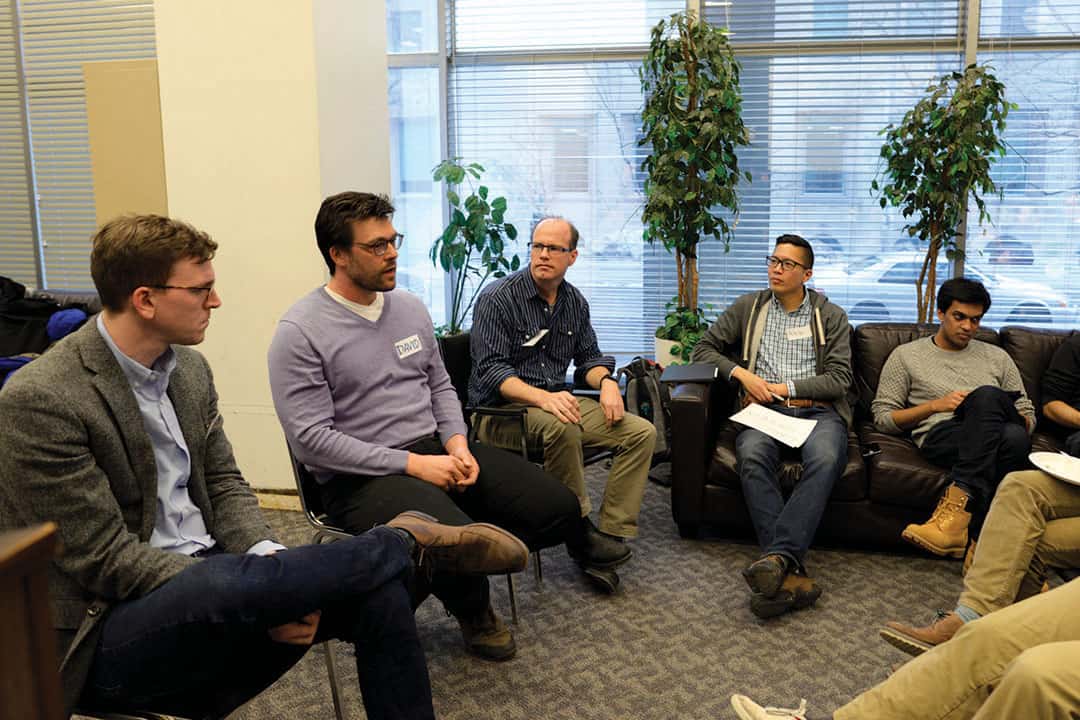At a panel earlier this month, undergraduates in the joint specialist Physics and Philosophy program at U of T posed philosophical questions arising from findings in physics to Professors David Curtin, Michael Luke, and Michael Miller at McLennan Physical Laboratories.
Dark matter and dark energy
Valentina Pentcheva, a Physics and Philosophy specialist, explained that dark energy and dark matter are unobservable components of reality, which compose 72 per cent and 23 per cent of the universe respectively. That leaves only five per cent of the universe observable.
Theories of dark matter and dark energy arose from researchers “trying to make sense of observations that contradict our physical theories up until now,” continued Pentcheva. Dark energy explains the “rapid expansion of the universe” while dark matter explains the movement of stars at the edge of galaxies.
“How can we consider our science adequate, if we missed over 90 per cent of our universe?” asked Pentcheva.
Furthermore, should we conceptualize dark matter and dark energy as “real things,” or “should we instead be committed to them only as instrumental tools?” Finally, she asked if “is there any reason why we should be more confident in the truth of our current theories” rather than others that have been falsified.
Curtin, Assistant Professor of Physics, explained that dark matter and dark energy are indeed every real things, even though we cannot directly image them due to their inability to interact with light.
“Dark matter and dark energy are, in fact, extremely observable and extremely precise physical predictions and have very concrete physical consequences,” said Curtin. For example, when astrophysicists view the collision of two galaxy clusters, they can “map out the dark matter” involved in the collision using an observational technique called gravitational lensing.”
“Just because we can’t see it without eyes, doesn’t make it not right,” Curtin continued. “Dark matter is exceptionally robust empirically.”
But Miller, Assistant Professor in the Department of Philosophy, raised the point that empirically robust concepts in the past have been proven to be non-existent, such as the existence of luminiferous aether, a type of substance proposed to explain how light waves travelled through space, which was disproven in 1887 with the Michelson-Morley experiment.
After an in-depth discussion with Curtin and Luke, a professor in the Department of Physics, Miller noted that even if we cannot directly observe a concept theorized to exist, we can mitigate our concerns that the theory may be false by pursuing “multiple independent strands of evidence.” If each strand “independently demonstrates to us” that the concept exists, then we can be more confident that the theory works out — as in the case of dark matter and dark energy.
The validity of using instrumentation
Sasha Manu, also a Physics and Philosophy specialist, presented the background and questions for the second topic of discussion: observation. “Our sense experience clearly constrains what types of observations we are able to make,” said Manu.
But scientists can create “high-profile discoveries” such as that of gravitational waves using “countless electronic connections and computer programs running in unison,” which lets scientists send a “probe into nature far beyond anything possible with the bare senses.”
What connects the “undeniably dissimilar experiences” of direct observation and observation using instrumentation, such that we “treat them in many ways as being the same.” Moreover, Manu asked if we are “justified in doing so.”
Luke opened the discussion by saying that he agrees that no direct observation occurs with our senses when scientists look for phenomena such as gravitational waves or the Higgs Boson, an elementary particle studied in particle physics. However, he says that he thinks “that’s what science is” — using theoretical intermediaries to make observations of phenomena that are not directly observable.
He continued by explaining that every time physicists agree they understand something with a certain degree of confidence, they can use it as a basis or tool to explore other phenomena.
The nature of physical laws
Hannah Sousa-Fronenberg, a Physics and Philosophy specialist, asked the questions for the final topic of discussion: the nature of physical laws.
How is it that “real and abstract mathematical laws govern and influence the behaviour of regular physical objects? Do these real and existing laws cause physical phenomena to occur? Does this mean that the laws of nature existed ‘before’ the Big Bang?”
Miller opened the discussion, explaining that “there’s lots of different views on the issue,” but he wished to focus on two classes of them.
According to the first class of views, explained Miller, physical laws are “just kind of patterns in the way the world unfolds, and there’s nothing over and above that to say about how things happen.” And according to the second class, physical laws “actually govern the behaviour” of particles in the world.


